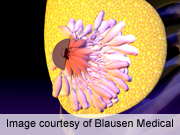
WEDNESDAY, Aug. 1 (HealthDay News) — A combination of two cancer drugs works better than one alone to improve survival in older women with a type of breast cancer that has spread, new research suggests.
The drugs — anastrozole (Arimidex) and fulvestrant (Faslodex) — are currently used individually to treat breast cancer, said researcher Dr. Rita Mehta, an associate professor of health sciences at the University of California, Irvine, School of Medicine.
For the study, published Aug. 2 in the New England Journal of Medicine, about 700 postmenopausal women were assigned to Arimidex alone or to both drugs. Mehta looked at whether the combination improved their survival, and whether the cancer spread or not, which is termed progression-free survival.
“With the combination, there is a 20 percent improvement in progression-free survival and a 19 percent improvement in overall survival,” Mehta said.
Put another way, those getting the combined treatment gained six months. They lived a median of 47.7 months (half lived longer, half less) while the solo-drug patients lived a median of 41.3 months.
The disease took 15 months to progress in the patients on both drugs, but just 13.5 on the solo drugs. Forty-one percent of the women taking Arimidex whose disease progressed later switched to Faslodex, which led the researchers to conclude that simultaneous treatment rather than sequential treatment brought about the benefits.
While other serious side effects were similar in both groups, three women in the combination-drug group died, which was possibly associated with the treatment.
The five-year study was supported by the U.S. National Cancer Institute and AstraZeneca Pharmaceuticals, which makes both drugs.
All the women had hormone receptor-positive breast cancer, which requires estrogen to grow and accounts for more than 50 percent of all cases of breast cancer.
Arimidex, which is given orally, works by reducing the amount of estrogen the body makes. Faslodex — an injectable drug — blocks the action of estrogen on cancer cells.
Previous studies of combination hormonal therapy have been unsuccessful, Mehta said. But she decided to look at this pair because of the complementary way in which these two drugs work.
The findings are solid, said Dr. Joanne Mortimer, director of the Women’s Cancer Program at the City of Hope Comprehensive Cancer Center, in Duarte, Calif.
Although the study had drug company support, the company did not have input in conducting the study, she noted.
While the improvement in progression-free survival, 1.5 months, may not seem notable, the difference in overall survival is impressive, she said.
“Much more important to the patients is if they live longer,” she said. ”Survival is the gold standard.”
Adding Faslodex to Arimidex treatment would tack on about $700 a month, experts said. However, as both drugs are FDA-approved, insurance plans may cover the regimen. The dose of Faslodex used in this trial was less than the standard dose.
Several other regimens to help women with this form of breast cancer are under study, too, Mortimer said. “We are not sure how this [particular] combination will be incorporated into clinical practice,” she said.
More information
To learn more about breast cancer, visit the U.S. National Library of Medicine.

